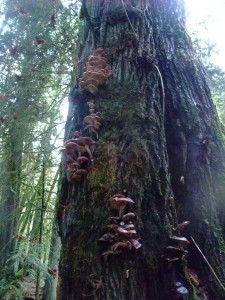Armillaria
Distribution: It is currently thought that there are over 30 species of Armillaria in the temperate regions of the world. The two most common in Western North America are A. mellea, attacking mostly hardwoods, and A. ostoyae which attacks mostly conifers. These heart rot and root rot pathogens are can be diagnosed by the characteristic white mycelial fans beneath the bark and on roots, black rhizomorphs on roots or under bark, and of course the honey mushrooms.
General Information: Armillaria ostoyae, formerly Armillaria solidipes and Armillaria mellea, is the most common species of this genus in the western U.S. (Worall 2007). It is an extremely prevelant root rot and heart rot of many hardwoods and conifers. It attacks the sapwood and is able to progress under bark or between trees via black rhizomorphs. Scientists have estimated a single specimen in Malheur National Forest, OR to have been growing for some 2,400 years, covering 3.4 square miles. A. ostoyae grows and spreads primarily underground. It is only in the fall when the “honey mushrooms” fruit that there is visible evidence of the gigantic organism lying beneath (Moore 2000).
Implications: Armillaria ostoyae may lower timber productivity by reducing tree growth, causing direct mortality of host trees, or predisposing trees to attack by insects or pathogens (Woods et al). The extent to which forests are vulnerable to the fungus varies considerably from ecosystem to ecosystem, site to site, and tree to tree (Kile, G.A.).
Sources:
Kile, G.A., G.I. McDonald and J.W. Byler. 1991. Ecology and disease in natural forests. In : Shaw, C.G., III; Kile, G.A. 1991. Armillaria Root Disease. Agricultural Handbook No. 691. U.S. Department of Agriculture, Forest Service. 233 pp.
Woods, A.J. 1994. The behavior and impacts of Armillaria ostoyae in mature stands and plantations in the Shuswap region of British Columbia. Master of Science thesis. University of British Columbia. 119 pp.
Wargo, P.M. and C.G. Shaw III. 1985. Armillaria root rot: the puzzle is being solved. Plant Disease 69: 826-832.
Worall, J. 2007. Armillaria Root Disease. Forest Pathology. http://www.forestpathology.org/dis_arm.html. Web. 26 Nov 2012.
pp. 380-382

Leave a Reply